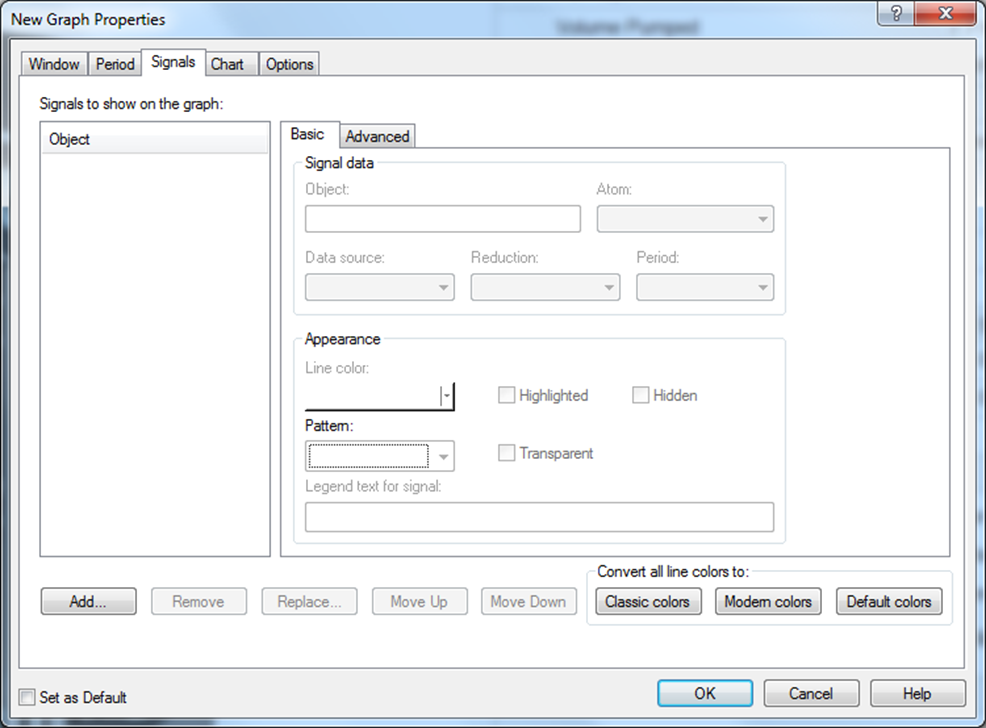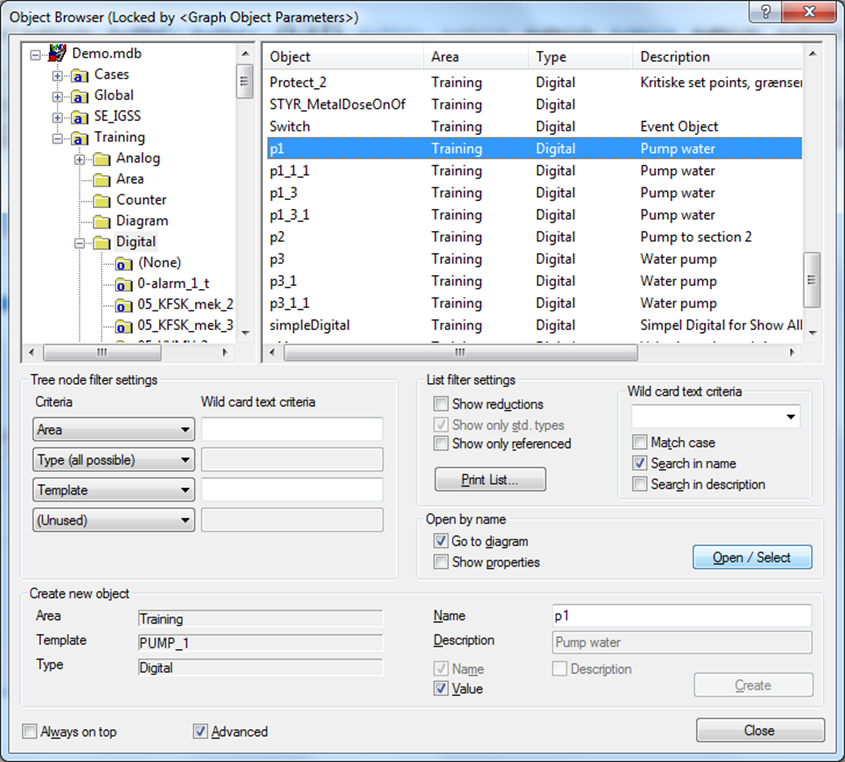Open topic with navigation
Add signals to a graph
When creating any type of graph, you can add one or more signals to the graph. A signal is a data input to the graph and is usually an Analog , but can be atoms from Digital, Counter and/or Table objects.
A graph can contain up to 16 signals, although it is recommended to keep the number of displayed signals as low as practically possible to improve overview and avoid cluttering the graph.
Signals from State and Command atoms from Digital objects are placed at the bottom of the graph.
Operators can add or remove graph signals in the Supervise module as well as hide and emphasize individual signals.
Open the Graph Properties form for an already created graph
- In the Definition module, click Graph > Open to access the New Graph Properties form for a stand-alone graph with its own window.1
- In the right pane of the Object Browser form, select the graph you want to define default properties for.
- Click the Open/Select button to open the graph and the Graph Properties form.
For an Embedded Graph2, displayed in a diagram, right-click on the graph and select Properties…
1 You can also select the graph in the Definition module’s Graph menu if the graph is accessible from that. If you are creating or editing a graph, the Graph Properties form will already be open.
2 Note that in the Embedded Graph Basic form graph properties are organized differently with fewer options.

Add graph signals
- Click the Add button on the Signals tab to open the Object Browser form.
- In the left pane of the Object Browser form, expand the folder and select the object type folder (Analog, Digital, Counter, Table) of the object you want to create a graph signal for.

- In the right pane of the Object Browser form, select the object you want to create a graph signal for, click Open/Select to add the selected object to the graph and close the Object Browser form.
- In the Graph Properties form > Signals tab > Basic sub tab. for each signal:
- In the Atom field, select which atom you want to display in the graph. Only atoms that have been enabled on the object will be shown in the drop-down list.
- Select a Data Source for the graph signal:
- Auto: If you select Auto, IGSS will automatically populate the graph lines based on the quickest and most readily accessible data set (Log and/or Reduced). Graph line detail will be rough to begin with and then improve as the graph continuously loads data.
- : The graph will only load any available LOG data. If an atom (signal) does not save object data in LOG files, the graph line will not display anything for that signal.
- Reduced: The graph will only load any available Reduced ( = Base Class) data. For Reduced data sources, you also need to select which data reduction method (enabled on the atom) to apply as well as which period to display reduced data for:
Auto: The fastest and best data are retrieved from all reduced data files - BCL and (HourDayMonth) - to draw the initial graph lines.
Base: BCL files are used to draw the graph lines.
Minutes, Hour, Day and Month are used.
NB! If you select a period which does not contain reduced data for the atom, the graph line will not be drawn.
- Online: The graph will only load online (live) process data. If an atom (signal) is not receiving online data, the graph line will not display anything for that signal. If the selected atom has not been set up to store object data in the data source specified (LOG or BCL), nothing will be displayed in the graph for that signal.
Note you cannot select a data source type which the selected atom is not set up to store.
- In the Appearance group you define:
- Line color: Select the color you want to represent the signal line in the graph. At the bottom of the Graph Properties form you can select among various color schemes:
Classic colors are used in IGSS version 11 and older and are brighter and sharper than Modern so-called “flat” colors, which are less shiny, and used in IGSS version 12 and newer. Each set of Classic colors are mapped to a set of Modern colors, and you can convert the color schemes back and forth. In the color palette you have a choice of modern and standard (classic) colors, and you can mix your own colors.
Default colors are a number of pre-selected modern colors that will be used as default line colors if you don’t select any others. Line colors are: Blue for the first signal, the following are red, green, light blue, orange, purple, grey, brown etc. Highlighted box: Select if you want the signal’s graph line to be bold. An operator can always remove signal highlights by right-clicking the signal and selecting Remove high-light.
Hidden box: If your graph has > 1 signal, select this box if you want hide the line of the selected signal. An operator can always display a hidden signal by right-clicking over the dimmed signal legend in the graph and selecting Show.
Pattern: Select a pattern for the part of the graph below the signal line
Transparent: Select if you want the graph’s pattern to appear transparent
- In the Legend text for signal field, enter your own text to use for the signal legend. The text will be suffixed to the automatic signal legend (object/atom name).
You can decide whether or not to show the automatic signal legend on the Chart tab.
- In the Graph Properties form > Signals tab > Advanced sub tab, for each signal:
- Select the Show Y-axis for this signal check box to display the Y-axis for the signal selected in the left pane of the Signals tab. You can clear this check box when displaying multiple signals. Operators can display or hide individual Y-axes during runtime display of the graph.
- In the Axis limits group, define how the limits of the Y-axis are displayed:
- Automatic: The graph will attempt to set the upper and lower limits of the Y-axis and adjust it automatically based on the lowest and highest values in the signal data.
- Automatic with zero included: As above but with zero displayed.
- Limits from object: Select this to use the atom limits (minimum and maximum) of the object selected in the Signals to show in the graph pane as lowest and highest values on the Y-axis. The maximum and minimum limits defined on the object in the Maximum and Minimum fields or High Scale and Low Scale atoms on the Object Properties form.
- Fixed limits: Define your own minimum and maximum limits for the Y-axis for the graph only (any defined values for the atom will not be used). Values higher or lower will not be displayed in the graph. The Y-axis will automatically be adjusted to reflect the new limits, distributing the Y-axis scale values evenly along the entire axis.

-
You can rearrange existing signals, replace them with another signal and remove existing signals from the list by using the Remove, Replace, Move up/down buttons.
- Click the OK button to save the period and close the Graph Properties form.
If you want to set up additional graph properties, click one of the other tab pages to continue graph set up.
TIP! You can set the present graph properties as the default parameters for all future graphs by selecting the Set as Default check box.
In the Embedded Graph Basic form graph signals are defined in the Objects tab.
See Also
What is a graph?
Set graph properties as default values
Create a new graph in a separate window
Create an Embedded Graph
Define the visibility of embedded graphs
Create and edit an Embedded Graph Basic
Graph Properties Form
Change graph properties
Protect a graph
Delete a graph
Connecting objects to each other
Reference a graph from a symbol
Object Naming Rules
Filtering the object list
Open topic with navigation



